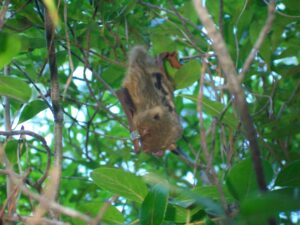Northern Yellow Bat 
Scientific Name: Lasiurus intermedius
Description.
The northern yellow bat is named after its yellow-brown or yellow-orange fur. One of the largest of the NC bats, they weigh between 17 and 22 grams and are about 118 to 129 mm long on average. Females tend to be larger than males, but this is the only sexual dimorphism present in the species.
Distribution.
Northern yellow bats are only found in the southeastern US, stretching from Virginia to Florida and from the east coast inland to the Southern tip of Texas. These bats have also been found as far inland as Austin, Texas. Northern yellow bats roost in Spanish moss but may also use dead palm fronds. They utilize mixed hardwood and pine forests, as well as pine groves.
Ecology and Behavior.
Northern yellow bats are highly solitary, though females will form maternity colonies during the summer, and feeding aggregations in the fall. Feeding aggregations happen while offspring are still on the wing and the mothers participate in communal feedings. Males, on the other hand, are very solitary and rarely participate in any group activity like communal feedings.
Food and Feeding.
The northern yellow bat typically feeds on dragonflies, ants, leafhoppers, mosquitoes, and diving beetles. They do most of their foraging in areas like pastures, golf courses, and the edges of lakes and forests, which are open and grassy.
Reproduction and Development.
Mating occurs in late fall and females will store sperm until fertilization in spring. On average, females will have 2-3 offspring even though they usually carry 3-4 embryos. Mating and reproduction is not fully understood for this species yet.
Status.
Northern yellow bats are listed as “least concern” even though they are somewhat rare outside of Florida where their populations are thriving. The biggest threat they face is habitat destruction. As of now, White-Nose Syndrome isn’t a threat to this bat species but scientists are keeping a close eye on these bats since the disease targets eastern bat species and has been steadily expanding its range.
- Click here to see where you can find the Northern Yellow Bat in NC!
